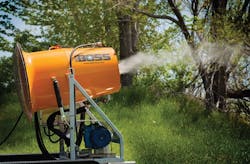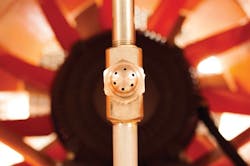“As regulatory concerns and public scrutiny continue to escalate, we feel that more companies will be looking at odor management as an increasingly important issue.”
Michigan Sugar is the third-largest beet sugar processor in the U.S. and the only remaining sugar company in the state of Michigan. Originally founded more than a century ago when six independent sugar beet companies merged, the firm has perfected the process of turning one of the region’s largest cash crops into pure, all-natural sugar.
In 2004, the organization became a grower-owned cooperative, and today approximately 900 growers have a stake. Together they farm 161,000 acres, delivering about 5 million tons of beets annually — enough to produce approximately 1.3 billion pounds of sugar each year. Counting its three warehouses in Michigan and Ohio, the company employs approximately 700 people year round and an additional 1,600 during peak processing season.
In all, Michigan Sugar Company’s seven facilities generate more than half a billion dollars annually in direct economic activity. Its products include granulated sugar, powdered sugar, brown sugar and liquid sugar, sold in wholesale and retail quantities under the Pioneer Sugar and Big Chief Sugar brands.
The Bay City factory was originally constructed in 1901 and remains the largest of four Michigan Sugar plants. With a daily slice of about 8,700 tons of sugar beets during its production campaign (usually 200 to 220 days), the facility typically processes 1.5 million tons per year, yielding more than half a billion pounds of sugar annually.
With company owners and employees all living in and around the areas where the facilities are located, management is acutely aware of its role as a corporate citizen. "We have always strived to be a positive force in the communities where we operate, and to demonstrate responsible environmental stewardship," said Bay City Factory Manager Gary Witzgall. "We believe that we can have the greatest positive impact by supporting issues and causes that are important to our grower-owners, neighbors and employees right in their own communities."
As part of that philosophy, company officials take a number of proactive measures to control the inevitable odors that accompany sugar beet processing. The first step is washing the incoming stock, catching the debris and depositing it into a settling pond. Effluent moves through several purifying stages — including anaerobic digestion, aeration and clarification — while microbes feed off the residual sugar and effectively clean the water.
One detail that differentiates the manufacturing operation at the Bay City plant is an additional step beyond conventional processing. "In most sugar beet factories, at the end of the process you have the final product with a quantity of molasses left over," Witzgall said. "We process that molasses again in a special operation to extract even more sugar. "It helps us maximize our resources and reduce waste."
At the end of the process, a slurry is created with water jets to allow the remaining settled solids to be pumped into tanker trucks. The mixture is recycled by transporting it back to the fields, where it is injected into the soil as a nutrient-rich organic fertilizer. The disturbance from the high-pressure water jets tends to release large amounts of odor vapor as the liquid reaches the proper consistency.
Although the perimeter misting system forms a barrier surrounding the ponds, it does not reach far enough to interact with the odor at its worst — as it is being generated.
The odor control mixture is delivered through an open-ended barrel with a fan on one end and the atomizer nozzle on the other.
To supplement the perimeter system, the company first attempted to mitigate the odor from slurrying by using atomized mist equipment designed for snow making. While the unit had some beneficial effect, plant operators felt that it was not sufficient, so operations personnel began searching for a better technique to improve odor control. Company officials wanted to enhance their odor management capabilities in a further effort to prevent any objectionable odors from leaving the property.
During that search, they contacted Dust Control Technology (DCT), supplier of the OdorBoss brand of odor control equipment and visited a scrap yard where the firm’s equipment was being used to control odor in a large outdoor operation. After seeing the method effectiveness of the deodorizer that was being applied, they decided to rent an OB-60G for a month when the ponds were being emptied.
Re-engineering odor control
Based on the manufacturer’s industrial fan-driven dust suppression products, the unit has been engineered to deliver a finer mist that is better suited to odor control. The odor control system manufacturer already had industrial-strength, durable designs that effectively at suppressed dust, and dust suppression and odor control are based on similar principles of matching the droplet size to its target.
The closer the water droplet size is to the size of the odor vapor droplets, the more likely the chance that the two will collide.
The atomizer nozzle creates an engineered fog of tiny droplets, which travel with the odor vapor.
The system creates an engineered fog comprised of millions of tiny droplets as small as 15 microns in diameter (approximately twice the size of a human red blood cell), which travel with odor molecules on air currents. The model is designed with an injection system that precisely meters odor management additives for maximum effectiveness. The manufacturer recommends starting with a 1,000-to-1 water-to-additive ratio and adjusting if necessary.
Suppression is delivered by a special, open-ended barrel design containing a powerful fan on one end and the company’s Odor X Atomizer nozzle on the other. The device is mounted on a towable trailer that also is fitted with a 500-gallon (1,893 liter) water tank.
The need for odor control is growing in many different industries, with large-scale food processing operations among them. As regulatory concerns and public scrutiny continue to escalate, companies more often appreciate odor management as an increasingly important issue.
Mobility
The unit can be repositioned quickly on its trailer to accommodate changing work locations or shifting wind patterns. Engineered to be moved and adjusted with changing conditions by a standard pickup truck or small skid steer, the low-maintenance unit runs for up to 16 hours on a single tank under normal operating conditions. The design can also be set for specific oscillation arcs and aimed precisely to intercept odor vapor where the concentration is highest.
Since the unit is transportable, if there is a problem area or a drastic change in wind direction, it can be quickly and simply hitched to a pickup truck and repositioned. In only a few minutes the unit is back in operation.
Results
After running the unit 24/7 for a month at the Bay City plant, operators found it so effective they decided to extend the rental for another month. "We’ve done a lot of homework on odor control systems, traveling across the country looking at different methods in action," Witzgall said. "We haven’t seen anything with this kind of mobile, yet high-strength, platform. It does a nice job for us, and we plan to rent again next year."
Odor complaints are down since implementing the odor control equipment, and visitors to the site have remarked on the unit’s effectiveness. "Odor management is our company’s top priority," Witzgall said. "Although it’s largely behind-the-scenes work, we are continuously making improvements to our process that help us better control the smell. That includes re-designing some of our piping routes, adding the perimeter misting system and experimenting with various filters. I suspect there will be millions in capital investments made in the next few years. We’ve made some great strides, but we’re not stopping there."
Resources
1. "Reference Guide To Odor Thresholds For Hazardous Air Pollutants Listed In The Clean Air Act Amendments Of 1990.” Air Risk Information Support Center, Environmental Protection Agency, March 1992. http://goo.gl/nQhQZ2.
2. Armitage, Sarah, "Summary of Nuisance Odor Strategy Changes Based on Public Input." Oregon Department of Environmental Quality, March 2014. http://www.oregon.gov/deq/docs/NuisanceOdorChanges.pdf.
3. "Particles: Size Makes All The Difference." National Institute of Environmental Health Services, Research Triangle Park, NC, 2006. https://www.niehs.nih.gov/health/assets/docs_a_e/ehp_student_edition_lesson_particles_size_makes_all_the_difference.pdf.
Derek Schussele is a member of the sales team at Dust Control Technology where he helps analyze and solve dust and odor problems. He also plays a role in the technical side of the business, working to refine both the technology and supporting documentation. Schussele has traveled extensively, investigating dust management issues. He holds a Bachelor’s of Science in biological sciences from Eastern Illinois University.



